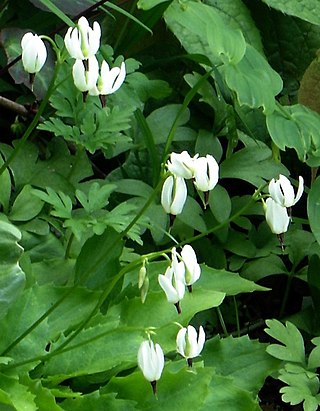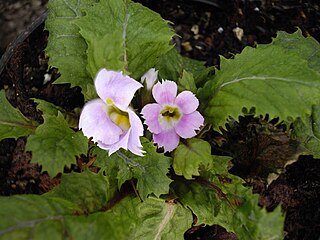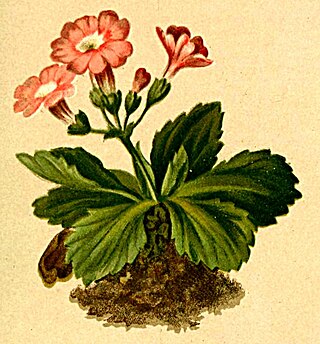
Primula vulgaris, the common primrose, is a species of flowering plant in the family Primulaceae, native to western and southern Europe, northwest Africa, and parts of southwest Asia. The common name is primrose, or occasionally common primrose or English primrose to distinguish it from other Primula species also called primroses. None of these are closely related to the evening primroses.

Primula scotica, commonly known as Scottish primrose, is a species of flowering plant in the family, Primulaceae, the primroses and their relatives. It was first described by James Smith, and is endemic to the north coast of Scotland.

Primula pauciflora, the pretty shooting star, few-flowered shooting star, dark throat shooting star or prairie shooting star, is a species of flowering plant in the primula family Primulaceae. It is a widespread and very variable species, native to western North America, from Subarctic America to Mexico, often in xeric and desert habitats. It is found in the Great Basin Deserts and Mojave Desert. Its synonyms include Dodecatheon pauciflorum and Dodecatheon pulchellum.

Primula fragrans, synonym Dodecatheon redolens, has the common name scented shooting star. It is a species of flowering plant in the primrose family.

Primula denticulata, the drumstick primula, is a species of flowering plant in the family Primulaceae, native to moist alpine regions of China, Afghanistan, Bhutan, India, N Myanmar, Nepal, and Pakistan. It is an herbaceous perennial growing to 45 cm (18 in) tall and wide, with rosettes of oval leaves and sturdy stems bearing spherical umbels of purple flowers in late spring and early summer. Flowers can also be lavender, pink, or white in colour. Kashmir is a disputed territory. Hence, deleted Kashmir from the list of places to which primula denticulata is a native. Such goof-ups should be edited before posting articles in such public domains

Primula latiloba, synonyms Dodecatheon dentatum and Dodecatheon latilobum, is a species of flowering plant in the family Primulaceae, known by the common names white shooting star and toothed American cowslip.

Primula austrofrigida, syn. Dodecatheon austrofrigidum, is a species of flowering plant in the primrose family known by the common names frigid shooting star and tundra shooting star. It is native to Washington and Oregon in the United States, where it grows in the coastal mountain ranges, including those on the Olympic Peninsula.

Primula poetica, synonym Dodecatheon poeticum, is commonly known as the poet's shooting star or the narcissus shooting star. P. poetica is a species of the genus Primula placed in section Dodecatheon. It is native to the states of Oregon and Washington in western North America. The section contains herbaceous flowering plants and is also a part of the primrose family Primulaceae. This plant has basal clumps of leaves and drooping flowers that occur at the apex of tall stems that rise from where the leaves join.

Primula marginata, the silver-edged primrose, is a species of flowering plant in the family Primulaceae, native to the south western Alps of France and Italy.

Primula bracteosa, the orange throated primrose, is a perennial species of primrose which is found on rocky crevices and of ravines at the altitudes of 2,300–2,700 metres (7,500–8,900 ft) in southern Xizhang, Bhutan, northeast India, Sikkim and Nepal.

Primula nutans, also known as the sleepy primrose, is a species of flowering plant belonging to the family Primulaceae.

Primula stricta, also known as the strict primrose, is a species of flowering plant in the family Primulaceae.

Primula scandinavica is a species of flowering plant in the family Primulaceae.

Primula algida is a species of flowering plant within the family Primulaceae. This species was first described by Michael Friedrich Adams.
Primula minor is a species of flowering plant within the family Primulaceae. It was first described by Isaac Bayley Balfour and Frank Kingdon-Ward in 1915. It is a close relative of the species Primula graminifolia.

Primula daonensis is a species of Primula within the family Primulaceae.
Primula heucherifolia is a species of flowering plant in the family Primulaceae.
Primula boveana, also known as the Sinai primrose, is a species of flowering plant within the family Primulaceae. The species was named in honour of botanist and plant collector Nicolas Bové.
Primula filipes is a species of flowering plant within the genus Primula and family Primulaceae.

Primula glutinosa, also known as the sticky primrose, is a species of flowering plant within the family Primulaceae.
















